This is a fortnightly newsletter about the New Zealand Net. If you would like to be notified by email when a new edition is published, please contact ZL1NZ.
Browse our Newsletter Archive and List of Net Tips.
Featured key

Akrad keys. Photos: CT4SL (left) and ZL2WT
By David ZL2WT
All three of the unlabeled morse keys in the Western Bay Museum, pictured in the previous edition of NZ Net News, are familiar to me.
One is an Akrad key. These were made for WWII recruits, and would-be recruits, to learn to send Morse code.
Akrad Radio Corp (the name Akrad stood for Auckland Radio) was founded in 1932 by Mr KM Wrigley, and was based in Waihi.
In 1940 there were about 30 staff and by the end of the war this had increased to a little over 100. Akrad made many parts for the ZC-1 transmitter/receiver and also the buzzer assembly for army field telephones.
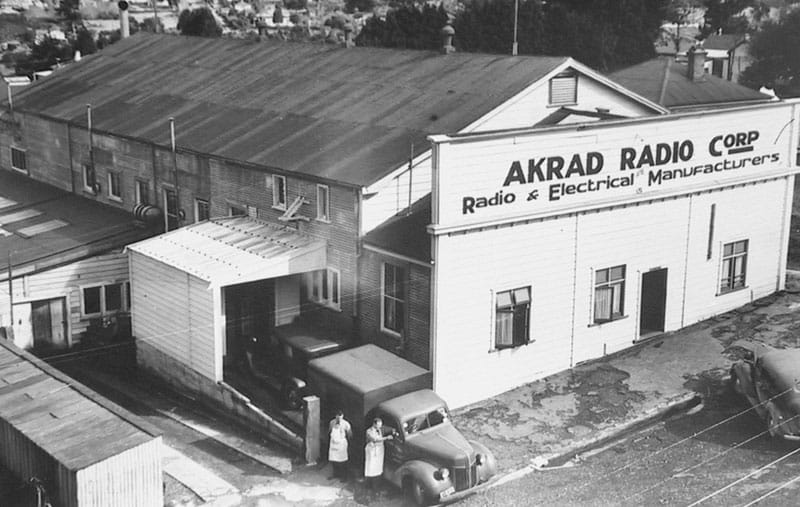
Akrad factory building in the 1940s
Akrad later became Pye NZ.
About 20 years ago I did research into all the keys that were known to have been made commercially in NZ. I had the goal of making a collection of one example of each model. The Akrad key was not easy to find. The collection, which I did complete, was disbanded some time ago.
In the next edition of NZ Net News, David will describe another of the “mystery keys” at the Western Bay Museum.
* If you have an interesting key for this feature, please send me a nice clear photo and a few words describing it.
Quick notes
 The Waitakere Sprint CW Contest is Saturday evening 7 August. The Sprint is of one-hour duration on 80m, and is open to amateurs in New Zealand, Australia and Oceania.
The Waitakere Sprint CW Contest is Saturday evening 7 August. The Sprint is of one-hour duration on 80m, and is open to amateurs in New Zealand, Australia and Oceania.
Field Day results have been published. Congratulations to the winners and thanks to all the CW ops that participated.
John G4ETQ in Truro, England, created this animation of someone who looks strangely familiar. Although there is no sound, if you watch closely you should be able to tell what the operator is sending. (If not, you can blame his aging fist.) Can you work it out?
During the 21 July NZ Net, Gerard ZL2GVA sent a message to all stations marking the first anniversary of his first check-in to the net. Here it is:
Straight Key Night is looking for a new manager. If you’d like to take this on, please contact ZL1NZ.
Manny’s noisy net
Here are typical receiving conditions at VK3DRQ. Unfortunately, Manny is hampered by high noise and no CW filter in his IC718. It’s a good thing ZL2GD and ZL4KX have strong signals to VK3. Have a listen.
- Bede ZL4KX uses an IC-7600 and IC-2KL amplifier at 400W into a coax-fed dipole 10m high.
- Grant ZL2GD uses an IC-7610 and solid state amplifier at 450W into an inverted vee 10m high.
- Manny VK3DRQ uses an IC718 at 100W into a trap dipole 8m high.
Amazingly, a few days after Manny sent me this recording, conditions on 80m got much better. My noise level dropped from around S5 (on a good evening) to about S2, and Manny’s signal went from QNP most evenings to QRK4. He has been copying the NZ stations better too. No doubt this is temporary, but I am sure enjoying the improved conditions.
Photo flashback
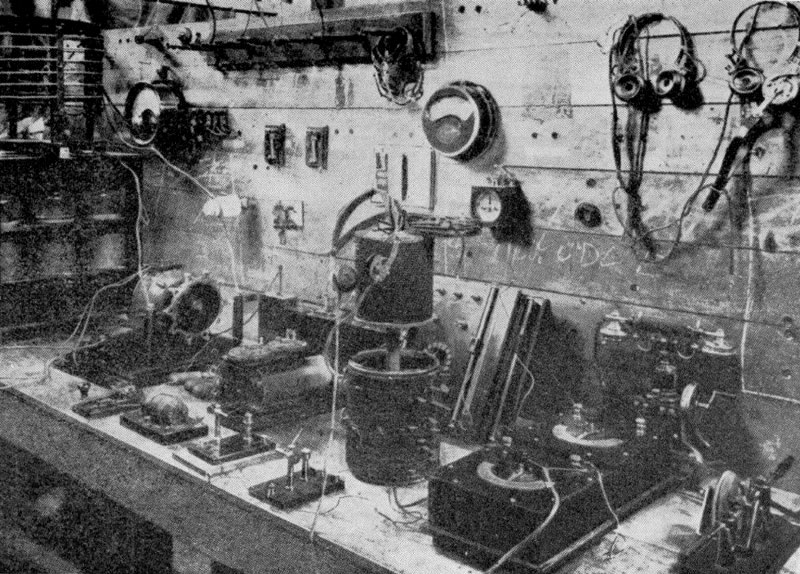
1911: The operating position at wireless station NZW in the Chief Post Office, Wellington
On 26 July, it will be exactly 110 years since New Zealand’s first official wireless station went on the air.
The station was NZW in Wellington. Located in the tower of the Chief Post Office, it was only intended as a temporary station. The government had already secured land on Tinakori Hill, and the station moved there the following year, adopting the new callsign VLW. Later known as ZLW, Wellington Radio was closed in 1993. You can still visit the site where part of the transmitter building remains in use for telecommunications.
Of course, NZW wasn’t really the country’s first wireless station. Teenage radio amateurs Rawson Stark, Stanton Hicks and Cyril Brandon in Dunedin made the first wireless contacts among themselves almost three years earlier.
NZ Net Quiz: What am I?
Can you identify this object? I’ll give you a couple of clues after the photo.
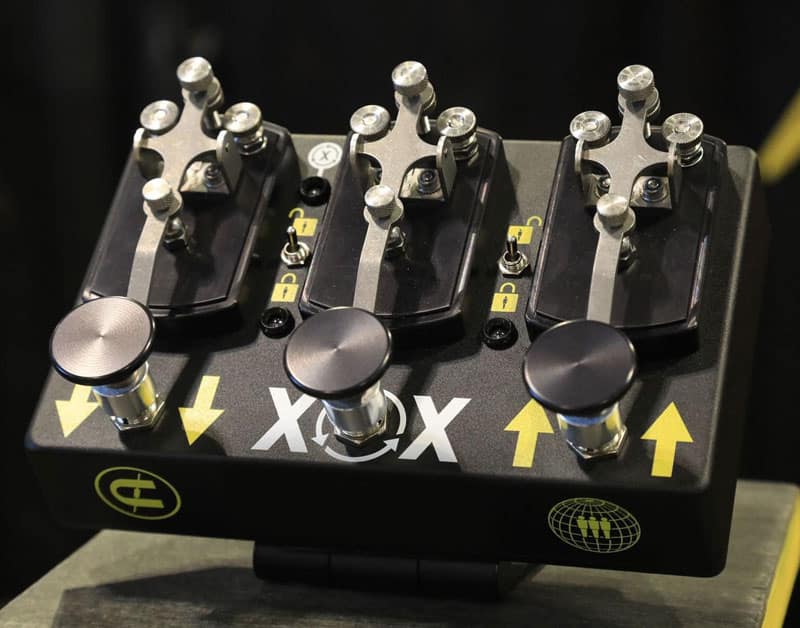
Brand name removed, just to make it a little harder!
Clue #1. It is a real product, which you can purchase.
Clue #2. Despite its appearance, it is not used for Morse code.
If you think you know what it is, or even what its purpose might be, send me your answer via radiogram. A virtual chocolate fish could be yours!
Grid squares in radiograms
By Stan ZL3TK
Those who have been listening to traffic on the NZ Net may have heard the wind-up dealt out by Stephen ZL1ANY. He eclipsed the meek 3-pair Maidenhead ‘Square’ rendition in my radiogram’s ‘PLACE OF ORIGIN’ field, with a cheeky 4-pair locator in his reply! It was pretty jolly good as a locator for ham use, bearing in mind that Maidenhead rectangles measure 700m x 420m on the ground.
That triggered some research. My first discovery was a bunch of math formulas to increase the standard Maidenhead granularity from 3-pairs to 4 or more pairs. I’m not ashamed to say working those formulas is hard work, so decided to continue the research trying to discover something simpler, and found this utility.
While that site claims to provide the option for either 3-pair or 4-pair granularity, after being unable to find a way to activate 4-pair, consultation with the author revealed that only 3-pair resolution is provided – though he kindly offered to add 4-pair … if reasonable justification by a number of users could be shown for it. I couldn’t guarantee that.
Meantime, accepting that Google isn’t the ne plus ultra of search engines, interrogation of a lesser digital encyclopaedia flagged a site which turned out to provide 5-pair Maidenhead granularity, all with only a few clicks on the mouse.
Five-pair resolution converts to rectangles measuring 30m x 18m on the ground, only 4.28% of the 3-pair rectangle size. This effectively enables identification of every individual residential building. Imagine how the Funkabwehr des Oberkommandos der Wehrmacht would have relished such a staggering level of accuracy while driving their little 1940s era RDF vans around occupied Europe.
The challenge has been laid, the ball is at your feet chaps, you can kick in as much or as little resolution to your radiograms’ ‘PLACE OF ORIGIN’ field as you wish, up to ten characters. Do all agree that we have a new tool to build one’s alpha-numeric traffic handling skills?
Video: Secret Life of the Radio (remastered)
Hope you enjoyed that video, including the extra commentary from Tim Hunkin at the end. Wasn’t that an amazing bit of hardware at 29:46?
Audio challenge
Here is a prediction from a famous person. Who said it, and were they right? Send me you answer by radiogram. Usually I do these challenges at 20wpm, but this one is a little faster (25wpm) for extra fun. 🙂
In the previous NZ Net News, we had a recording of Norddeich Radio / DAN transmitting their farewell message on 500 kHz radiotelegraphy. One of the stations to answer was OXB (featured in NZ Net News Nr 57) and their message ended with an intriguing little word that I asked you to identify. It was SRI, as in “Sorry”. I wonder if this was a bit of ad libbing by the OXB operator – it doesn’t sound like the sort of thing that would be part of an officially approved message for such circumstances, although it was probably sincere.
I received the correct answer first from ZL3TK, then from ZL1BWG and ZL2GVA.
Net tip: Keeping notes
How does a Net Control Station keep track of the traffic listed during the Net? There are lots of ways, I’m sure, but in the picture below you can see how I do it, using an A4 spiral-bound notebook to log the check-ins to each Net session.
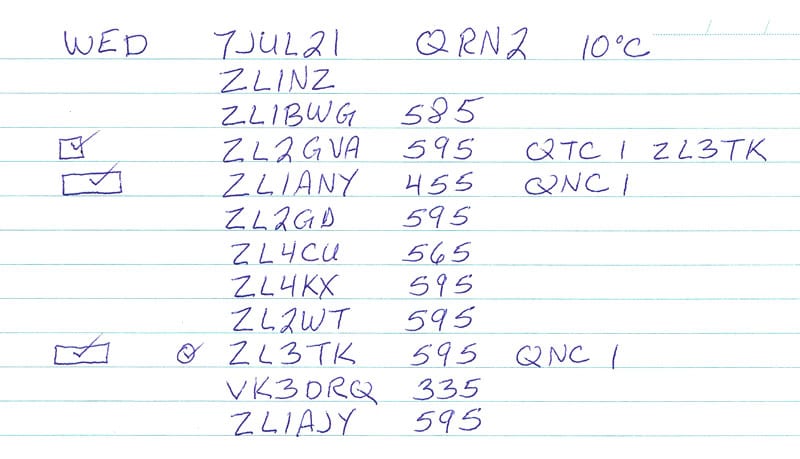
Most of the above probably needs no explanation. The signal reports are RSN, although I normally send them as RST since RSN might not be familiar to some operators.
You might be wondering about the squares and circles in the left-hand margin:
- If a station has traffic, I draw one square box for each QTC that they list.
- If a station lists a QNC, I draw an oblong box for each QNC.
- A circle indicates that a station will be receiving a message (one circle for each message).
My mnemonic for this is that circles look like targets, while boxes look like a “to do” list. 🙂
If I am NCS, I refer to this list to help me clear traffic on the Net.
First, I will look for any QNC, and ask the relevant station(s) to send it. When they finish, I put a tick mark in the QNC box beside their callsign.
Then I will ask stations with squares or circles to wait, and will QNX all other stations. Then we work through the traffic. As each radiogram is QSLed I put ticks in the relevant square and circle and then QNX anyone who doesn’t have more traffic to send or receive.
My notebook is also where I copy all radiograms that are not for me. I do this so I can provide a relay if needed. Messages addressed to me, on the other hand, go on radiogram forms and get filed.
At the end of each Net session, I record the QNIs and QTCs in a spreadsheet which automatically totals the daily numbers as well as each station’s number for the monthly NZ Net Report.
Do you have systems you use for logging the Net? Please share your ideas.
Advertising archive
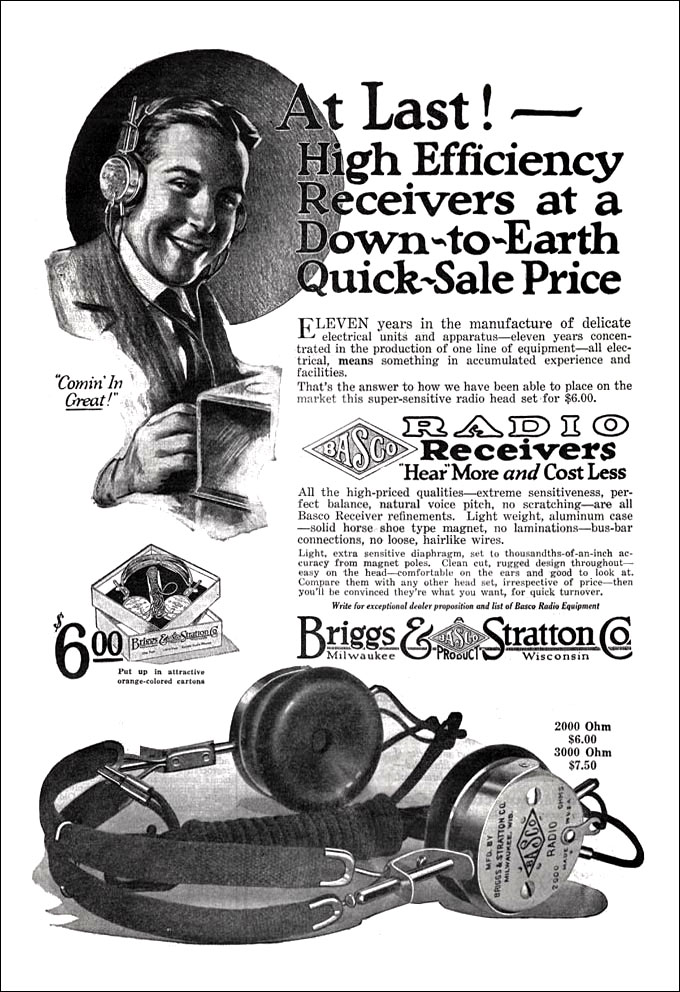
Radio News, October 1922
Did you know that Briggs & Stratton, the US company famous for its lawnmower engines, used to make radio headphones and other radio parts?
This advertisement seems to have been aimed at radio dealers, and I find it interesting that US$6 was touted as a “quick sale” price. That’s US$97 in 2021 money, or about NZ$140. Radio enthusiasts would pay any price for great reception, right?
Suggestions?
If you have suggestions on how to make the NZ Net better, or things you’d like to see covered in these updates, please contact ZL1NZ. You might even like to write something for the newsletter.
Thanks for reading, and I hope to see you soon on the NZ Net!
—
Neil Sanderson ZL1NZ, Net Manager
New Zealand Net (NZ NET)
3535.0 kHz at 9pm NZT Mon-Fri




